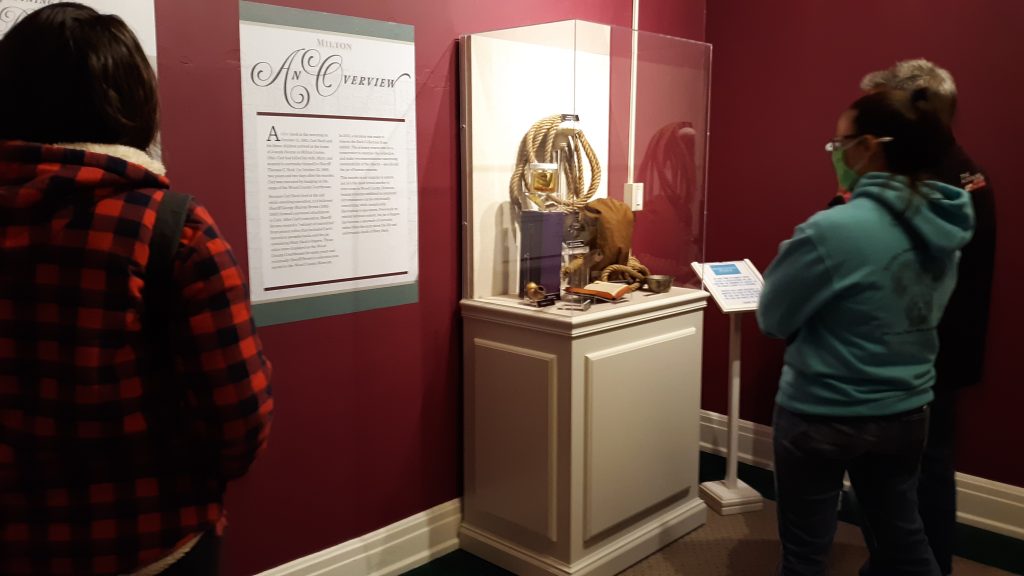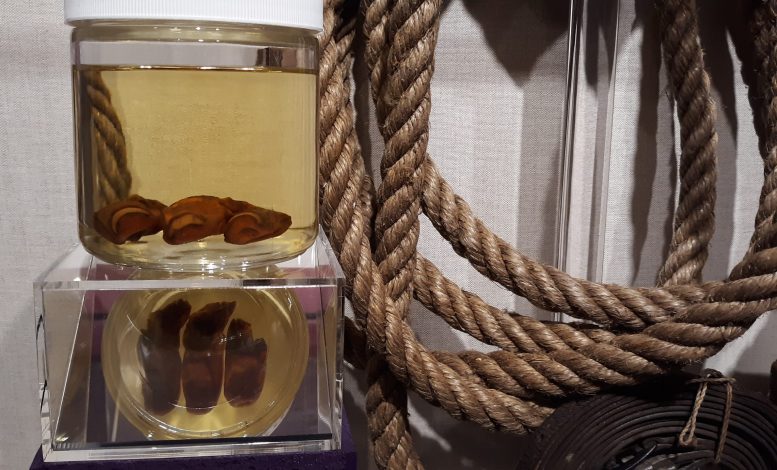By JAN LARSON McLAUGHLIN
BG Independent News
For more than a century, Mary Bach’s shriveled fingers in a jar were the gruesome remnants of the Wood County woman murdered by her husband in 1881. The fingers – not the story of the woman they came from – were the biggest draw at the county historical museum.
In 2015, the fingers were removed from the museum exhibits – in an effort to make sure they were being properly preserved.
On Wednesday, her hydrated fingers were back – along with a more complete story of Mary Bach’s life and death.
“This is finally a chance for Mary Bach to tell her story,” said Kathy Mull, executive director of the Cocoon domestic violence shelter. “This is the first opportunity to tell about Mary, who very tragically lost her life to domestic violence.”
Mary Bach had five siblings, four children, and was seven months pregnant when killed. She and her husband, Carl, had married in Cleveland, where he had been jailed one month for hitting Mary.
The family moved to a farm near Milton Center in 1869. Carl Bach had a couple bad years with crops, and went into debt. He wanted to sell the farm and move further west.
But Ohio required that both the husband and wife sign off on selling property, according to Holly Kirkendall, curator at the county museum. Mary Bach feared that once the farm was sold, Carl would take off with the profits and leave his family destitute.
So she refused to sign off on the sale, and went to Weston to try to get a divorce.
“In 1881, there weren’t a lot of options for women,” Kirkendall said.
In October, as the weather got colder, Carl Bach reportedly told his wife that he wanted to move back into the house instead of sleeping in the barn. Mary Bach turned him down.
He returned to the barn, got a long-bladed corn knife and went back to the house. Carl Bach struck his wife 18 times with the knife. He then told the children to go back to sleep.
At 5 a.m., he walked the children to a neighbor’s home, then went to Bowling Green to turn himself in.
Neighbors said Carl Bach talked for years about wanting to kill his wife. He complained about sleeping in the barn and grumbled that Mary was not cooking for him. While he complained that his wife was lazy, others pointed out that she was seven months pregnant and was a pleasant person.
Carl Bach reportedly expected to get life in prison.
“He was very surprised they sentenced him to death,” Kirkendall said.
His execution became a spectacle itself. Tickets were sold for his hanging, conducted outside the Wood County Courthouse. An estimated 10,000 spectators showed up, so the National Guard was called in to keep the peace.
It was the last hanging conducted in Wood County.
The coroner put three of Mary Bach’s fingers, cut off with the corn knife, in a jar of whiskey since there was no other way available to preserve them. They were originally displayed in the courthouse, then later moved to the county museum.
In 2015, the fingers were sent to Ohio History Connection, which has experience preserving pieces of history.

Thursday was opening day for the new exhibit about the Bachs. In addition to the fingers, there are panels of information and a video about the family and the crime. Other items on display include the straps used to tie Carl Bach’s feet and the head covering used at the hanging, the corn knife used to kill his wife, his German Bible, and the tin cup he used in jail.
At the opening of the exhibit, a relative of Mary Bach attended out of curiosity. Karen Espen, of North Baltimore, grew up knowing the story about Mary’s tragic life.
“We always knew the story,” Espen said, explaining that her cousin researched the family’s history. “I told the kids that this would be a history lesson today.”
The Cocoon collaborated with the Wood County Museum on the renewed exhibit.
“Domestic violence is just as prevalent today as it was back in the 1800s,” Mull said, noting that the Cocoon worked with 717 domestic violence survivors last year. “This brings light to the toll domestic violence takes on families.”
During the official ribbon cutting, Bethany Eschedor from the Bowling Green Chamber of Commerce, talked about the changes over the last century.
“In Mary Bach’s time, nobody talked about this kind of stuff,” Eschedor said. Countless museum visitors viewed her fingers over the years, but “it’s just so much more than that. For so long she was silent, but now she has a voice.”
Some of those who contributed to the exhibit also spoke. Kathy Newlove, whose daughter, Alicia, was killed by domestic violence, talked about the value of the exhibit.
“This is such a wonderful exhibit to have to create awareness,” Newlove said.
Museum Director Kelli Kling thanked all involved.
“This really shows that our community believes history is valuable and so relevant today,” Kling said.





